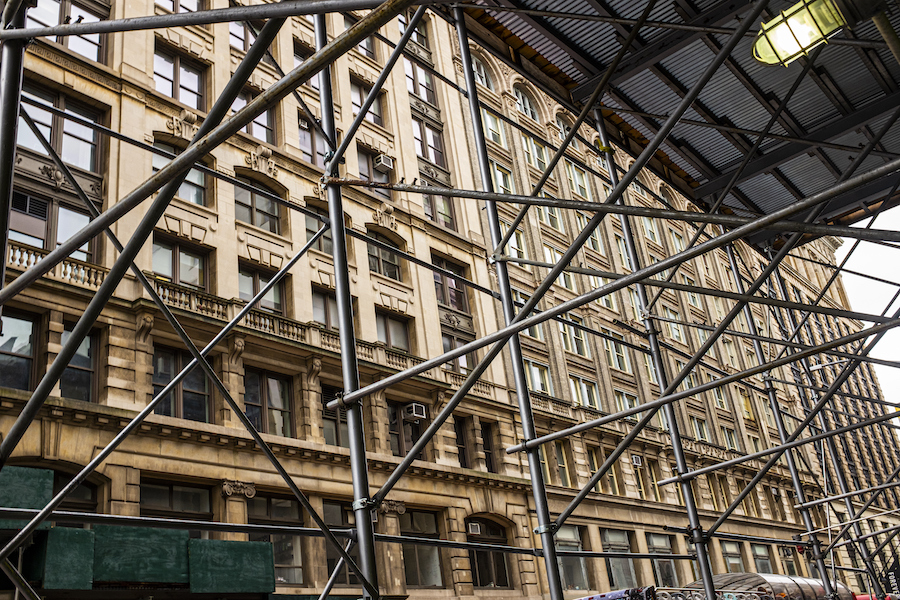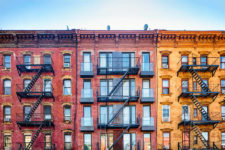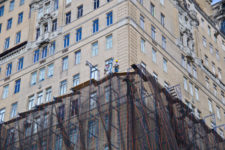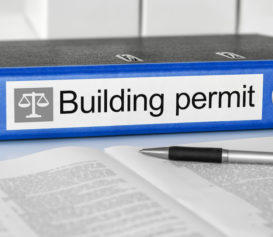Manhattan Borough President Mark Levine just released a proposal for sidewalk sheds that could impact future DOB facade filings. While these proposed solutions have a long way to go before they become law (if they do at all), it’s good to know where the industry is heading – and what that means for your buildings.
Below is a summary of the plan’s core strategies – you can read the full proposal here.
Why Shed the Shed?
According to quote from Levine referenced in Crain’s, sidewalk sheds (also known as scaffolding) are “a blight on our neighborhoods.” Also noted in the article are some key stats:
- There are more than 9,000 sidewalk sheds citywide
- Including over 4,000 in Manhattan alone
- All of which cover 2 million linear feet
9,000 sheds are still 20% less than the peak amount (11,000 sheds in 2020), with the decrease attributed to more DOB inspectors on the street and more frequent follow-ups.
Levine cites additional critical data in his full writeup, linked here:
- On average, sidewalk sheds are on city streets for 498 days
- Over 230 scaffoldings across the city have been up for over five years
In his recent Twitter thread, Levine notes that while sidewalk sheds are necessary to protect pedestrians from falling debris & equipment, and to protect construction and facade workers, they’re also “good idea[s] run amok.” He also introduces his 5-part strategy for speeding up sidewalk shed removal. Each strategy has a few main elements, which we’ll cover below.
Strategy 1: Expedite Facade Work
Provide low-interest loans to buildings struggling to complete facade work/comply with Local Law 11 requirements
Levine proposes that “the State should pass legislation to allow the City to run a low-interest loan program for qualifying buildings with a demonstrated financial hardship,” including HDFCs, affordable home ownership programs, non-profits, and rent-regulated buildings. The loan program would be specifically for facade repair work and protections and prevailing wages for workers.
Create an accelerator program for owners/boards struggling to make decisions about construction, financing, engineering, and LL11 compliance broadly
Per Levine, the DOB should create an accelerator program specifically for facade work. That includes access to expertise and guidance, much like existing city accelerator programs for sustainability.
Strategy 2: Reduce Delays
Expedite façade permitting processes at Landmark Preservation Commission by expanding the staff available and dedicating a unit specifically to Local Law 11 compliance
Delays at the LPC (and the DOB) may contribute to sidewalk sheds being erected and in place long before work actually begins. Levine hopes any landmarked properties or buildings in historic districts will be avoided with increased staff and a dedicated team handling requests.
Allow property owners to petition for access to neighboring properties when necessary
Here’s the full quote from the MBPO’s plan:
The State should allow for mediated negotiation between property owners when access to
neighboring properties is required, rather than court intervention. Conflicts between property
owners can seriously delay the start of a project, but mediation could help ensure that façade
inspections and repairs are done as quicky [editor’s note: sp] as possible so that scaffolding can be taken down
There’s a lot wrapped up in this section (How would it work? Does it just apply to facade work, or other kinds of work? How does it align with/infringe on existing laws?), so more details are certain to come if the State takes action here.
Strategy 3: Increase Accountability – aka, Enforcement
Note: These next three strategies (3, 4, and 5) would potentially have the biggest impact on the current facade filings process, and existing enforcement levels.
Create a task force to identify why the City is among the worst offenders of long term scaffolding deployment, and identify how to correct those challenges
Here, accountability is turned inward. Per the full plan, “On average, sidewalk sheds are up for over a year on City-owned property.” The new task force would presumably identify why, and take steps to manage existing scaffolding.
Increase fines and civil penalties on buildings who fail to quickly complete work
While the plan notes that civil penalties have been recently increased, they’re calling on the fine schedule to be increased again. Additionally, quickly isn’t defined here – it’s possible they would leave that measurement to the council or the DOB, should this request ever happen.
Exercise emergency powers to perform work on buildings that fail to correct unsafe conditions
This strategy would take advantage of DOB’s authority to perform emergency work and charge owners via property liens.
Create a program to assist tenants who suffer from long-term scaffolding deployment
Under this proposal, tenants would be entitled to rent abatements for decreased services. Specifically, “The City should provide support to rentregulated tenants in filing for rent abatements and also offer support to market-rate tenants who withhold rent based on excessive scaffolding timeframes.”
Strategy 4: Update Local Law 11 Regulations
Allow drones to be used for facade inspections
In a big change from current rules, inspectors could utilize drones to improve the speed and efficiency of facade inspections. This proposal is already making headway with the city council via INT 452-2022 – you can read more about it here. That said, it’s currently being held over by committee with no clear timeframe or next steps.
Reform design standards to allow use of different designs and scaffolding types
Per the plan:
The vast majority of sidewalk sheds and scaffolding utilize the same designs that have been
in place for decades, while one company is allowed to use the popular but expensive “Urban
Umbrella” style. DOB should reform design standards to allow for additional types of scaffolding
and sidewalk sheds that could better fit the needs of local communities, including designs affixed
to the side of a building as well as scaffolding that is higher above street level. Additionally, more
companies should be allowed to utilize white paint, and reforms should be made to encourage
better and brighter lighting.
Strategy 5: Extend LL11 Compliance Cycles
Extend LL11 cycles by two years for buildings that complete major facade renovations
This strategy encourages the DOB to create a program that allow buildings post-renovation to enter a 7-year cycle (instead of the ongoing, recurrent 5-year cycle).
Extend inspection schedules for new buildings made with lower risk materials
New construction buildings made with materials other than terra cotta would potentially get an extension from 5 years to 7 years for the first 2 inspection cycles.
What’s Next?
There’s a lot at play here, including requests to New York State and City agencies (including the DOB and Mayor’s office). If members of the city council agree with any of the proposed strategies (and if it’s within their scope of the law), they may pass legislation that then moves to DOB’s rulemaking process. All said, it may be some time before any of the above strategies are in effect – if at all. Of course, if any make it to the rulemaking process, you’ll have an opportunity to comment and share your thoughts with the DOB directly.
Stay tuned – we’ll keep you posted on any updates from the City, State, and the DOB.




